White Ash Tree: Leaves, Bark (Pictures) – Identification Guide
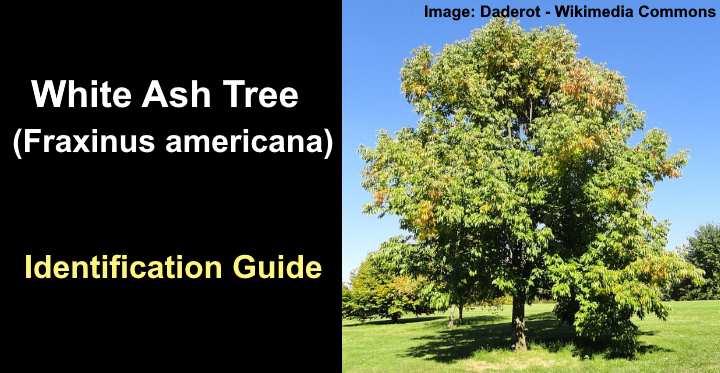
The white ash tree is a majestic deciduous shade tree with dark green pinnate leaves, silvery-brown bark, and clusters of small greenish or purple flowers. The large, branching white ash is identified by its irregular pyramidal or rounded crown, dense foliage, and stunning red fall colors. Also called the American ash tree, this ash species is popular as a specimen tree and often lines streets because it is easy to grow and tolerates challenging urban conditions.
This article provides a comprehensive guide to identifying the white ash tree. You will find descriptions and photos of the tree’s distinguishing characteristics — its flowers, leaves, bark, and seeds. There are also handy tips on growing and caring for a white ash tree if you want to plant one in your garden landscape.
White Ash Facts
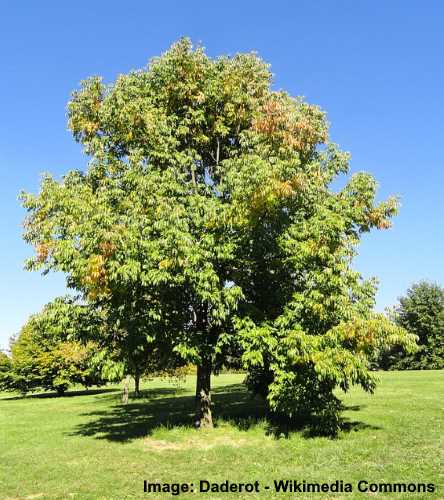
White ash (Fraxinus americana)
White ash (Fraxinus americana) is a hardwood deciduous tree species native to North America. The ornamental tree is in the ash tree genus Fraxinus and the olive family Oleaceae. White ash trees are recognized by their compound leaves, upright spreading branches, oval or pyramidal shape, and white timber.
White ash (Fraxinus americana) grows 60 to 80 ft. (18 – 24 m) tall and wide. The beautiful shade tree has a medium growth rate and averages between 12” and 24” (30 – 60 cm) per year. Under ideal growing conditions, you can expect white ash to grow for up to 200 years if it doesn’t succumb to disease.
Native American ash trees thrive in USDA zones 3 through 9. The ash trees perform best growing in full sun and organically rich, well-drained loamy soil. Although it prefers six hours of sunlight daily, white ash also tolerates some shade, and established ash trees are relatively drought tolerant.
White ash trees are the most common trees from the Fraxinus genus growing in the United States. Apart from being prized as an easy-to-grow street tree or landscaping tree, white ash timber is also valuable. The robust and white-colored hardwood is used to make baseball bats, tool handles, oars, hockey sticks, furniture, and flooring.
White Ash Leaves
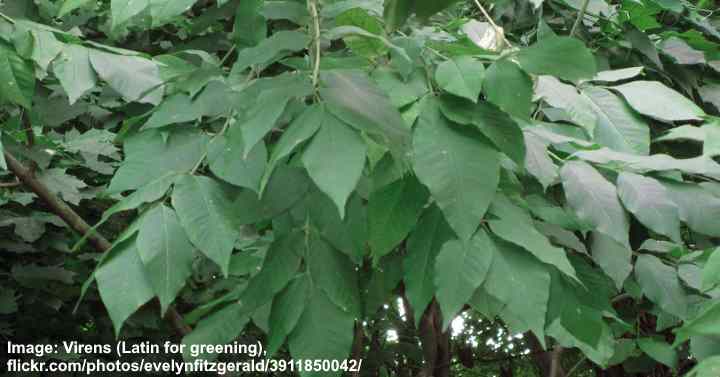
White ash leaves
Leaves on the white ash tree are identified as pinnately compound, with each leaf typically comprising of seven leaflets. Individual leaflets are pointed, lance-shaped blades growing oppositely and measuring 3” to 5” (7.5 – 13 cm) long. The entire white ash compound leaf measures 8” to 12” (20 – 30 cm) long.
White ash tree leaves emerge dark green in late spring. The leafy foliage on the tall tree creates a dense canopy ideal for shade in parks and residential gardens. In the fall, white ash leaves turn brilliant yellow, deep red, and deep purple colors.
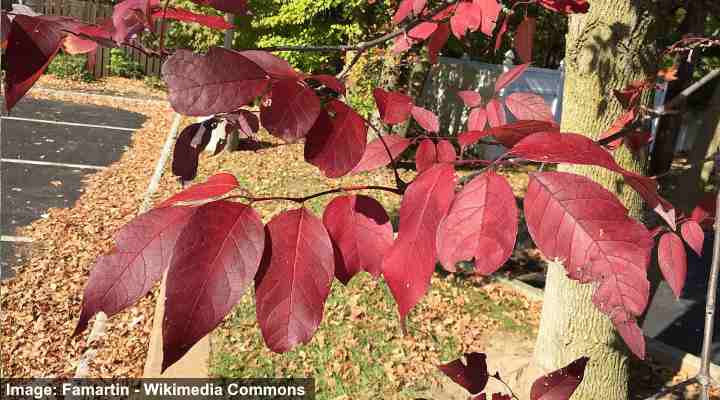
White ash autumn leaves
White ash tree leaves have a whitish underside which is how Fraxinus americana gets its common name.
White Ash Bark
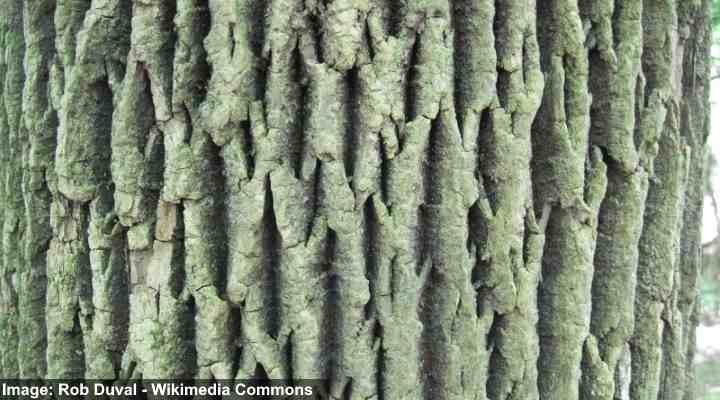
White ash bark
White ash bark is a distinctive gray or light brown color that develops deep furrowing as the tree matures. An identifying trait of white ash bark is the distinct diamond pattern or net-like structure and pointed ridges covering the straight central trunk.
White ash twigs and stems are an attractive olive-green color with a smooth feel. The stout greenish twigs have a notched top with three lateral buds at the end.
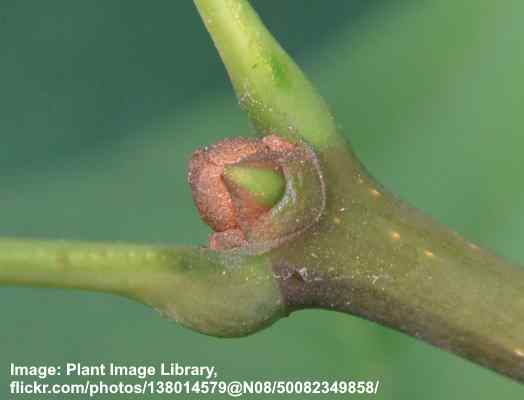
White ash bud
White Ash Tree Flowers
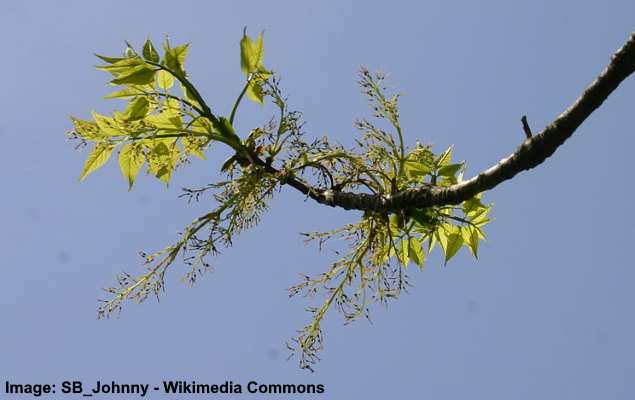
White ash flowers
Flowers on white ash trees are clusters of small, fuzzy blooms that appear in spring. White ash trees are classified as dioecious — male and female flowers appear on separate trees. The panicles on female ash trees are loose clusters of light green to purplish flowers. Male flowers grow in tighter clusters.
White Ash Seeds (Fruit)
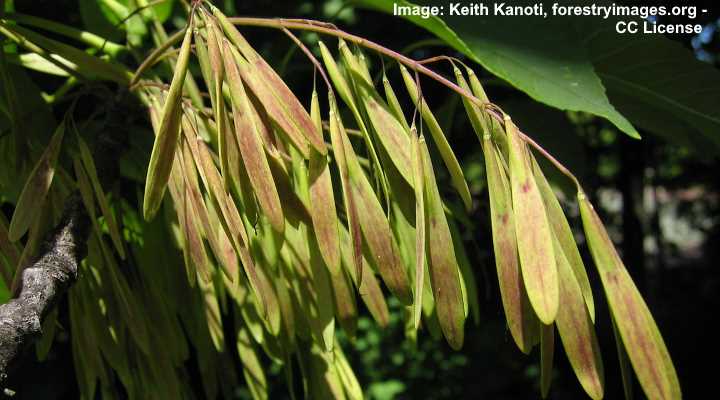
White ash seeds
After flowering, only female white ash trees produce fruit in the form of drooping clusters of flattened, winged seeds called samaras. The seed cases are oval and slender and a yellowish to pale green color. Masses of these pendulous samaras persist on the tree from August throughout winter, giving the white ash tree all-season appeal.
Seeds from white ash trees can become an issue in the fall as they are incredibly messy. If you want to avoid a fall clean-up, you can plant a male white ash tree — this is a seedless plant. After blooming, their small purplish flower clusters wither, and the tree doesn’t produce any seeds.
White Ash Tree Fall Color
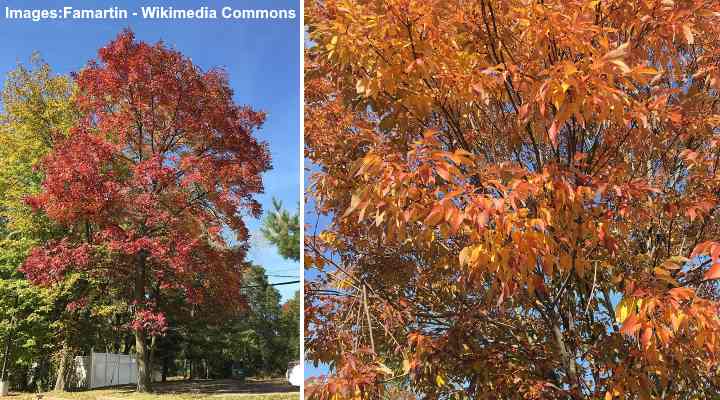
White ash in autumn
In the fall, white ash trees turn magnificent shades of orange-yellow, deep burgundy red, and purplish-red. In a landscape or city street, white ash trees add plenty of beauty and color in the fall. Many people describe white ash fall color as the most spectacular of all the species of native ash trees.
How to Identify White Ash Tree
White ash tree identification is by its large pinnately compound leaves with five to nine leaflets, a pattern of diamond-shaped ridges, grayish bark, and an irregular rounded crown. White ash is easy to identify in the fall by its vibrant yellow, red, or purple colors. You’ll also see characteristic clusters of samaras drooping from branches.
Where to Plant White Ash Tree
To grow a white ash tree, choose the sunniest location in your yard. The soil at the planting location should retain moisture but be well-draining and moderately fertile. However, it’s good to know that white ash will tolerate some shade and occasional flooding. Choosing the optimal planting spot is key to a white ash tree’s long-term health.
Spacing is another consideration when deciding where to plant a white ash tree. The tree matures at 50 to 80 ft. (15 – 24 m) and has a similar spread. You will need to plant the white ash 20 to 30 ft. (6 – 10 m) from buildings to avoid structural problems later.
If you are thinking about planting an ash tree on your property, it’s a good idea to learn about the emerald ash borer. This invasive iridescent green beetle is prevalent in many states and kills millions of ash trees per year. If the beetle is a problem where you live, it’s best to consider planting another native tree species.
How to Plant White Ash Tree
The easiest way to plant an American ash is to buy a rooted tree from a nursery. Start by digging a hole twice the width of the root ball and one foot (30 cm) deeper. Next, mix in a good amount of organic compost with the native soil to make it more fertile.
Next, plant the white ash in the hole, making sure it’s growing at the same height as the nursery container. Then backfill the hole, firmly pressing the soil around the tree’s root system. Finally, dig a small trench around the edge of the root area. This helps prevent water runoff and allows the roots to be thoroughly irrigated.
Growing a White Ash from Seed
Growing a white ash from seed requires patience because germination takes 18 months. To start, harvest seeds from October through winter by picking brown samaras still hanging on branches. Next, you will need to remove the seeds from their papery casings. The next step requires pre-treating the seeds before germination.
Soak the seeds in cold water for 24 hours, then drain them, soak for a further 24 hours, and drain them again. Then plant the seed in a pot containing equal parts of horticultural sand and peat-free compost. Put the seeds on the surface of the potting soil and cover them with 0.8” to 1.2” (2 – 3 cm) of sand.
Place the pots outdoors in a shaded spot and leave them for 18 months. Water the soil every so often to prevent it from drying out. To germinate, the white ash seeds should spend a whole summer and the following winter outside before planting in the ground.
If several seedlings sprout, you can transfer them to individual nursery containers to keep them growing. For example, when white ash saplings are 15” (40 cm) tall, you can transfer them to the garden and plant them in a sunny spot.

White ash seedlings
White Ash Tree (Fraxinus americana) Care Guide
White ash trees are relatively easy to take care of when planted in a yard. Ideally, the American ash requires six hours of direct sunlight and grows in fertile, well-drained, moist soil. Proper watering, fertilization, and pruning are necessary to ensure a white ash grows well.
How to Water White Ash Tree
White ash trees thrive in evenly moist, fertile soils. Therefore, you should water a white ash often enough so that the soil stays damp without being waterlogged. During the summer, you may need to water the tree every seven to ten days if there has been no rainfall.
However, regular rainfall should be enough during late fall and winter. Therefore, you generally don’t have to water a white ash tree between November and February.
It’s good to note that a newly-planted white ash requires more frequent watering. Water the plant daily for the first two weeks after planting a nursery tree. Then from week three to 12, water every two to three days. After three months, you can water the ash tree as usual.
White Ash Tree Fertilization
White ash trees are not heavy feeders. However, they benefit from annual fertilization in the fall. Apply a balanced tree fertilizer with an NPK rating of 10-10-10. Spread the slow-release fertilizer evenly under the tree canopy, leaving a 24” (60 cm) diameter free around the central trunk.
Pruning a White Ash Tree
Pruning a white ash tree is vital to encourage a robust branching system, remove dead or diseased limbs, and improve air circulation. The best time to prune white ash trees is in fall, just after the leaves have dropped. Pruning depends on the age of the ash tree.
Pruning young ash trees is necessary to develop a central, leader trunk. After the tree is a couple of years old, look for the most vigorous main stem. Then prune the rest of the stems to ensure a strong leader develops. Then annually, cut back any thin branches to increase air circulation.
Pruning established white ash trees is only necessary every few years. You should cut back broken, diseased, or dead branches to improve the tree’s health. Also, prune any branches crossed over or that rub against other limbs.
It may be best to call professional arborists to prune larger, mature white ash trees. This is especially true if the white ash is tall or growing near buildings.
Pests Affecting White Ash Tree Growth
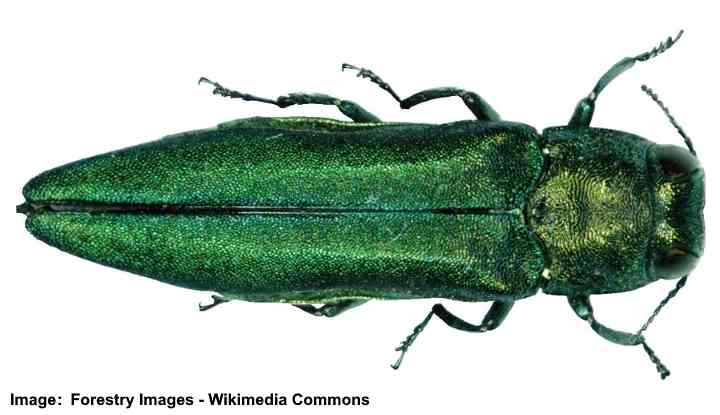
Emerald ash borer
The most destructive pest affecting white ash trees is the emerald ash borer. The tree-destroying beetles can kill a mature ash tree in a few years. Other pest issues with ash trees can be caused by aphids, ash plant bugs, caterpillars, ash sawflies, and gall mites.
Here is a short overview of pests affecting white ash trees:
Emerald ash borer (Agrilus planipennis) is an invasive green beetle that affects white ash trees. Called EAB for short, the beetle has a metallic green body and can quickly kill an ash tree. The beetle lays eggs between bark crevices, and when the larvae hatch, they bore into the tree.
Signs of emerald ash borer damage include dead leaves, dead branches, and chunks of bark that fall off, revealing a snaking pattern below.
If you notice signs of borer damage, you should consult with a professional to see if it’s possible to save the tree.
Ash plant bugs (Tropidosteptes amoenus) are tiny black insects that pierce leaf tissue and feed on sap. Typically, damage by ash plant bugs is only superficial, and they won’t harm the tree’s health. However, the dark green ash leaves can wilt, turn brown, and look twisted and deformed.
Caterpillars in the order Lepidoptera are often found defoliating white ash trees. It’s common to see hairy or striped caterpillars feeding on the leaves. The foliar damage is often so extensive that the hungry larvae skeletonize the leaves.
Leaf Curl ash aphids (Prociphilus fraxinifolia) affect green and white ash trees and feed on the underside of leaves. You can spot aphid damage on ash trees by the distinctive gnarled twig ends and clusters of curled leaves. Although the ash leaves look bad, aphids don’t affect the tree’s overall health.
Diseases Affecting White Ash Tree Growth
Several tree diseases can affect an ash tree’s growth and leaves. Spotting signs of fungal or bacterial disease can help you identify the problem and remove the infected part of the tree before it spreads.
Here are some common diseases affecting white ash trees:
Ash yellows (Candidatus Phytoplasma fraxini) is a bacterial infection that affects white ash tree growth. The signs of ash yellow are slow growth and small, light green leaves. Sometimes new branches grow in tufts. It’s vital to remove all infected parts of the tree before the disease spreads.
Ash anthracnose (Gnomoniella fraxini) is a fungal disease that causes large light brown or black patches to form on the margins of leaves. In severe cases, an affected white ash tree may lose all its leaves. Pruning and destroying affected branches, twigs, and leaves is the best way to preserve the tree’s health.
Ash rust (Puccinia fraxinata) is a common fungal disease that causes leaves to become twisted and distorted. You may also notice yellow or orange spongy growths on an infected white ash tree. Although the yellow cankers and deformed leaves make the tree appear sick, ash rust doesn’t harm trees.
Powdery mildew appears on white ash leaves as a dusting of gray to white powder or a fuzzy ash-gray film. This fungal infection is common on ash trees that have poor air circulation or grow in shaded, damp environments. The foliar disease may cause leaves to turn yellow or brown and drop early. However, it is rarely lethal to the tree’s health.
Related articles:
